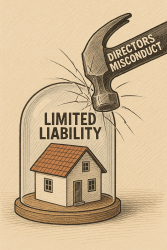
How to Save a Failing Business from Insolvency
A failing business is stressful for directors and its employees. Find out what the causes are and what can be done about it. Free advice
Read
How to Save a Failing Business from Insolvency
A failing business is stressful for directors and its employees. Find out what the causes are and what can be done about it. Free advice
Read
If My Company Goes Bust Will I Lose My House?
You will not lose your house if your company goes bust but if you have been guilty of defrauding creditors or have personally guaranteed company loans then it is possible.
ReadAm I Trading Whilst Insolvent? – Directors Guide To The Risks
Trading whilst insolvent is a legal term used to describe a business which continues trading when it cannot pay its debts and its liabilities are greater than its assets. It can lead to a breach of several provisions of the Insolvency Act 1986 which can result in the directors being held personally liable
Read
What Is Creditors Voluntary Liquidation (CVL)
Creditors voluntary liquidation is when the directors decide that their company should stop trading and its assets are "liquidated" and turned into cash. This is usually due to the company being insolvent and the directors do not want to be wound up compulsorily by the court.
ReadWill I Go Bankrupt If I Am A Director Of A Company That Goes Bust?
The content on this page has been written by Robert Moore and approved by Chris Ferguson Licensed Insolvency Practitioner and Managing Director of RMT KSA
ReadGuide To Liquidation Fees
The costs of liquidation start at around £4000 + VAT. This would be for liquidating a company with a single creditor, such as having an unpaid Bounce Back Loan (BBL) or HMRC. For more than one creditor issue, we would expect the fee to be approximately £4,400 - £6,000 plus VAT.
ReadHow Long Does It Take To Liquidate A Company?
Liquidating a company can take anything from 14 days to 2 years. It depends on the size and complexity of the business and the particular type of liquidation process the company is undergoing. A creditors voluntary liquidation takes a shorter time, generally.
ReadOverdrawn Director’s Loan Accounts in Insolvency
An overdrawn director's loan account is created when the director takes money out of the company, by the form of a loan, resulting in the director owing the company money. When the amount extracted is more than what can be put back in, the account is overdrawn.
Read
Director’s Credit Rating After Liquidation: What You Need to Know
The content on this page has been written by Eric Walls and approved by Chris Ferguson Licensed Insolvency Practitioner and Managing Director of RMT KSA
ReadWhat Is A Transaction At An Undervalue?
A transaction at an undervalue is when an asset is transferred for no payment or sold at below their true value. The transaction becomes a problem if the company is insolvent, as any transfer at an undervalue is in effect depriving the creditors of money owed to them. This is outlined in s238 of The Insolvency Act 1986.
ReadCan I Get Out Of A Personal Guarantee For A Company?
A personal guarantee is a guarantee by an individual, to cover, backup or indemnify something done by a corporate entity. For example a director guaranteeing to pay back a debt of the company if the company isn't able to.
Read
Creditors Meetings in An Insolvent Liquidation
The Creditors Voluntary Liquidation Process If a company is unable to pay its debts and is no longer viable then a Creditors Voluntary Liquidation (CVL) tends to be the best option. The directors start the process by appointing a licensed insolvency practitioner to put together a statement of affairs of the company and contact all the creditors. In a CVL, there are two key meetings. Firstly, a meeting with the company members and shareholders, secondly, a meeting with the company’s creditors. What Happens In The Meetings? With the shareholders and company members, the liquidators will discuss and decide upon a resolution to try and put the company into liquidation.Up to 14 days after the shareholders meeting (note: it can be arranged for the same day), a creditors meeting is arranged. A 7 days notice period must be given, to allow the maximum number of creditors to attend. With the notice, two other forms, a form of proxy and the proof of debt form, are given to creditors, which must be read, signed and brought back to the meeting.In a creditors meeting, the insolvency practitioner will explain the companies financial position and outline the statement of affairs. Additionally, the reason for the liquidation is shared. Within these meetings, creditors are allowed to ask questions regarding the information they’re being told. Funnily enough the most usual question is “where has all the money gone?” . At the meeting the creditors are asked to approve the insolvency practitioner as the liquidator. In some cases the creditors may not want the insolvency practitioner appointed as they wish to have more control of the process. As such, they will bring their own insolvency practitioner to the meeting who will seek to get appointed. Large companies that supply lots of businesses often go down this route, as do lenders. This is why the process is called “creditors” voluntary liquidation.A hardcopy of the statement of affairs is given to all creditors. Within 28 days of the meeting, creditors must receive a summary of the meeting and all agreements. What Is Section 98 of the Insolvency Act? The Insolvency Act 1986 outlines the legal procedures for all matters for everything relating to both personal and corporate UK Insolvency. Section 98 relates to the procedures for the creditors meetings.The procedure for the meetings of creditors can be found here https://www.legislation.gov.uk/ukpga/1986/45/section/98 .In 2016, a set of new rules was integrated into the 1986 version, to modernize the law. This document can be found here https://www.legislation.gov.uk/uksi/2016/1024/pdfs/uksi_20161024_en.pdf . The main changes to the 1986 law are discussed below. Firstly, the requirement for physical section 98 meetings, is abolished. Instead, virtual meetings or processes of deemed creditor consent are held. With processes of deemed creditor consent, the directors send written proposals to creditors regarding nominating a liquidator. If 10% or more object to these proposals, then the directors must call a physical meeting with creditors, to make a decision, if not, the proposal is approved.There are alternatives to deemed creditor consent. These are ;Correspondence Virtual meetings Physical meetings Electronic voting Any other decision-making procedures which allow creditors to have equal participation in decision-making.Another new rule is that final meetings have been abolished. This means that creditors now have a right to object to the proposal, within a period of 8 weeks from the delivery of the prescribed notice, or determination of applications for further information or challenges to remuneration.Other 2016 rule changes involve:Creditors now have the ability to opt out of emails Liquidators being required to send a progress report to all parties, every 6-12 months Creditors being able to communicate with debtors without consent, as long as the creditor and debtor have communicated previously The meeting being chaired by the administrator or someone appointed on their behalf, only.
Read